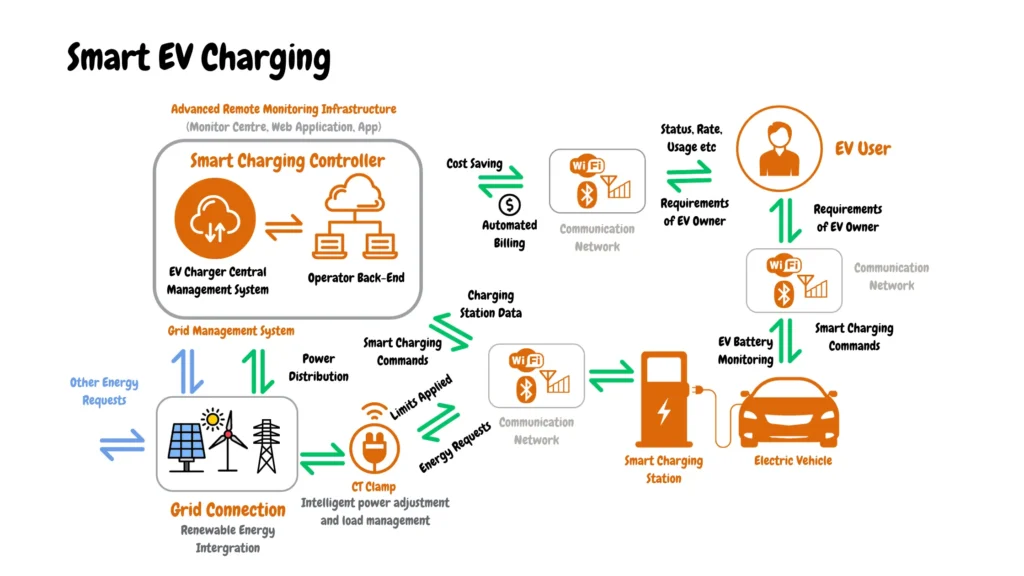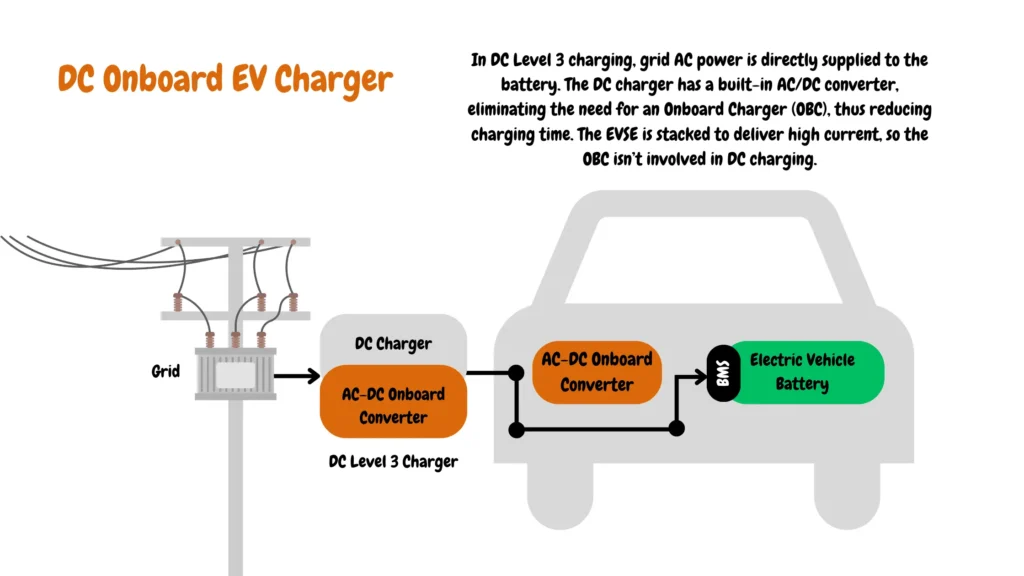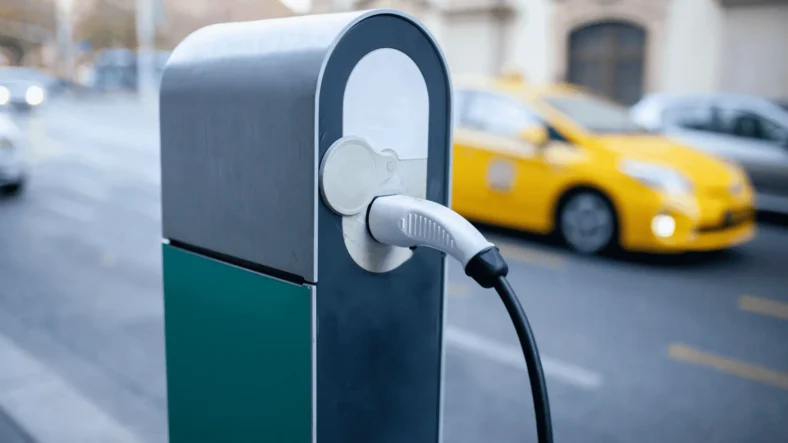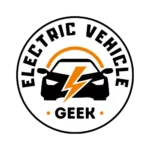Electric Vehicle (EV) charging infrastructure is the comprehensive network of physical components and systems designed to facilitate the charging of electric vehicles.
EV charging infrastructure is pivotal in promoting the widespread acceptance and practicality of electric vehicles. Essential elements of EV Charging Infrastructure include charging station units, charging cables, connectors, power supply mechanisms, EV charging management systems (payment systems, monitoring and tracking interfaces, safety protocols, network systems, cooling systems)
As an EV owner, you can’t be certain a charging station is available in the next corner, and if you find one, it might not be working; considering how charging stations haven’t kept up with the growth of electric vehicles, we recommend investing in a reliable Home EV Charger.
Components of EV Charging Infrastructure
To understand the components of EV Charging infrastructure, we have included an infographic image below that shows all the components of a smart EV charger, including key EV charging infrastructure components such as charging station units, charging cables, connectors, power supply mechanisms, EV charging management systems (payment systems, monitoring and tracking interfaces, safety protocols, network systems, cooling systems).

To promote interoperability, EVSE components are standardized by the International Electrotechnical Commission (IEC), the International Organization for Standardization (ISO), and the International Telecommunication Union (ITU).
Electric Vehicle Supply Equipment
The charging station is the heart of the EV charging infrastructure, including electric boards that house power electronics, communication modules, and safety mechanisms.
One of the notable power components found in a charging station unit is an onboard charger found in DC charging stations, which converts AC power to DC power.

On AC chargers, the onboard charger is not in the EVSE but in the electric vehicle.

The functions of an EVSE are to orchestrate the flow of electricity, communicate data with the electric vehicle, and safeguard the charging process, on advanced EVSEs (Smart Chargers), the EVSE contains electrical components that allow smart EV charging features such as payment systems, monitoring, and tracking interfaces, safety protocols, network systems, cooling systems.
Different Charging Stations include Level 1, 2, and DC fast chargers.
Level 1 Charging
Level 1 Charging provides approximately 5 miles of range per hour of charging, utilizing a J1772 connector with a standard NEMA 120 V AC plug. This is commonly used at home, requiring about 8 hours to replenish 40 miles of range. As of 2022, less than 1% of public EV charging ports in the United States were Level 1.
Level 2 Charging
Level 2 Charging offers around 25 miles of range per hour of charging, using a J1772 connector with 240 V (residential) or 208 V (commercial) electrical service. As of 2022, nearly 80% of public EV charging ports in the United States were Level 2. It operates at 40 to 80 amperes, with a Level 2 unit ranging from 2.9 to 19.2 kW power output.
DC Fast Charging
DC Fast Charging delivers approximately 100 to 200+ miles of range per 30 minutes of charging, with connector options like CCS, CHAdeMO, and J3400. As of 2022, over 20% of public EV charging ports in the United States were DC fast chargers. Charging power for a DC fast charging unit ranges from 25 to 350 kW, and it’s crucial for rapid charging along major traffic routes. Different connector types accommodate various EV models, with future adoption of standardized J3400 connectors expected.
EV Charging Cable
An EV charging cable is a physical bridge between the EVSE and the electric vehicle. Its main purpose is to transfer DC current in a DC Charger and AC Current in an AC Charger; EV charging cables come in various lengths and thicknesses depending on the EVSE current rating, one point of the EV Charging cable is connected to the EVSE and the other is connected to an EV Charging connector or Plug.
EV Charging Connectors
EV Charging connectors are also called plugs; they are found on the end of the EV Charging cable and connect to the electric vehicle power inlet to charge it.
Various types of EV Charging connectors exist in the market, they include, SAE J1772 Connector (Type 1), Mennekes Plug (Type 2) Mennekes Connector (Type 2), CCS Type 1 Plug CCS Type 1 Connector, CCS Type 2 Plug CCS Type 2 Connector, CHAdeMO Plug CHAdeMO Connector, GB/T Plug (GB/T – AC & GBT – DC) GB/T Connector (GB/T – AC & GBT – DC), and NACS Plug (Formerly Tesla Plug) NACS Connector (Formerly Tesla Connector) depending on the power inlet of your electric vehicle/ charger type, and charging standard.
EV Charging Power Source.
EV charging requires a power source to charge your EV; the power source can come from the Electricity Grid or renewable sources like wind or solar panels.
AN EV charging power source provides electric power in AC to the EVSE and can be measured in kilowatts (kW) or megawatts (MW), it’s important to find a reliable EV charging power source to match your EVSE requirements since this determines the charging speeds, and overall efficiency when charging your EV.
Advanced EV charging infrastructure is designed to integrate with smart EV grids, allowing for better load management, peak shaving, and demand response. This integration helps balance the electrical grid and optimize energy usage.
EV Charging Management Systems.
Depending on the features integrated into your EV Charging systems for smart charging capabilities, some key components might be included to help in power load management, payment processing, monitoring and tracking, safety protocols, network and communication systems, and cooling systems.
The State of EV Charging Infrastructure in USA.
According to SBD Automotive, a global automotive research company, a successful electric vehicle infrastructure will require a charging point for every eight to 12 electric vehicles over the coming years.
As of December 2023, the tapestry of electric vehicle (EV) infrastructure in the United States boasts over 165,000 public charging ports, marking a landscape shaped by dynamic growth. Since the inception of the Biden Administration, the number of fast-charging ports has surged by over 70%, signifying a rapid expansion in accessibility.
The intricate network includes approximately 53,400 charging stations and around 138,100 outlets, vividly showing widespread EV support. Notably, nearly 80% of the public charging ports are Level 2, affirming the prevalence of this charging tier. The universal compatibility of all commercially available EVs with Level 1 and Level 2 charging equipment further solidifies the nation’s commitment to fostering an inclusive and robust EV charging ecosystem.
However, as of December 2023, unit sales of electric vehicles were 3 million, meaning that we require a charging station for eight to 12 electric vehicles. we would need 250,000 EV Charging Infrastructure added each year; this figure will also increase if we reach 50% of electric cars on American roads in 2030, accounting for 26.4 million electric vehicles, requiring 2.2 million EV Charging Infrastructure in 2030.
To fill the gap in EV charging infrastructure, the government is investing in the Made-in-America EV Charging Network, which plans to install over 500,000 EV Charging infrastructures accessible in the United States by 2026, with a call to private investors to fill in the gap. Over $25 billion has been invested through public investment in EV charging infrastructure – More than $10 billion from the private sector.

Conclusion
As electric vehicles become an integral part of our transportation landscape, the role of EV charging infrastructure cannot be overstated.
This comprehensive guide has provided insights into the significance of charging infrastructure, current affairs, challenges faced, and potential future developments.
With continued technological advancements and private and public investment collaboration, the future of EV charging infrastructure looks promising, paving the way for a more sustainable and greener future in transportation.

James Ndungu is a certified EV charger installer with over five years of experience in EVSE selection, permitting, and installation. He holds advanced credentials, including certification from the Electric Vehicle Infrastructure Training Program (EVITP) and specialized training in EV charging equipment and installation, as well as diplomas in EV Technology and Engineering Fundamentals of EVs. Since 2021, James has tested dozens of EV chargers and accessories, sharing expert insights into the latest EV charging technologies.







